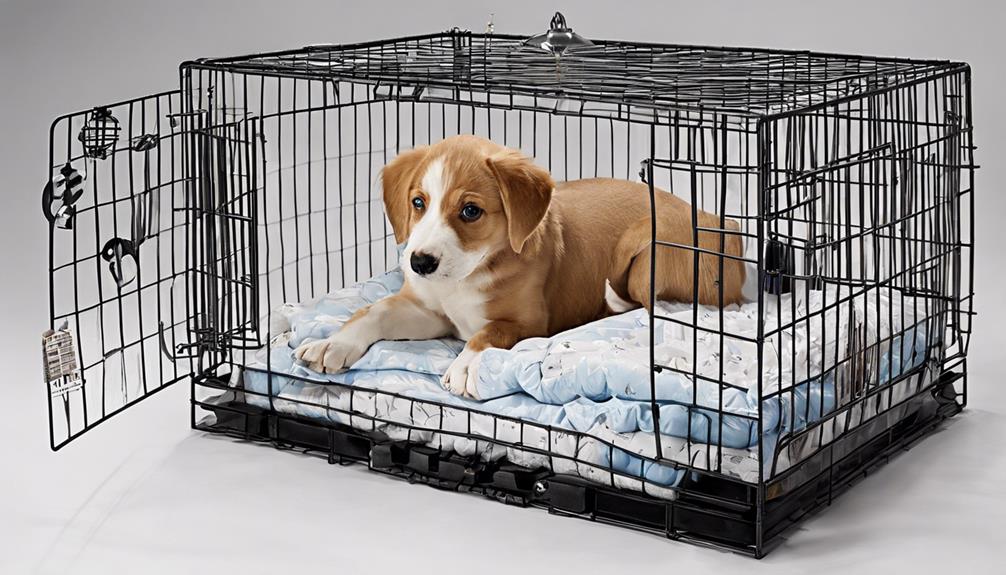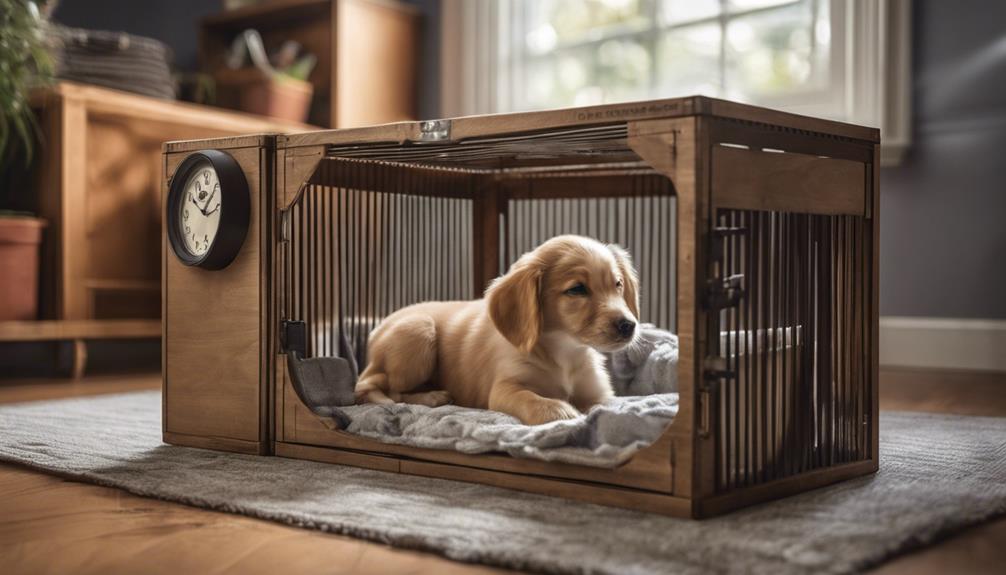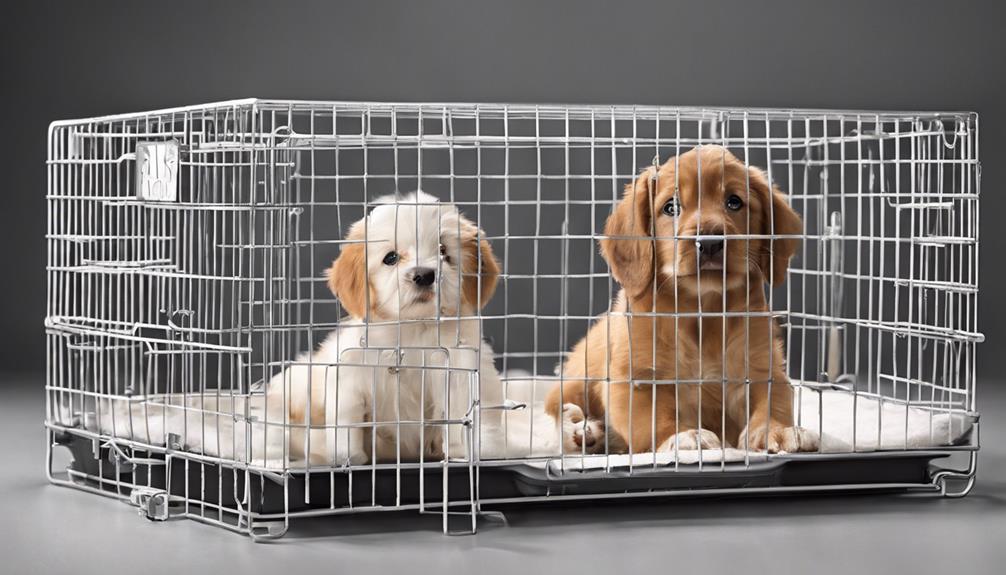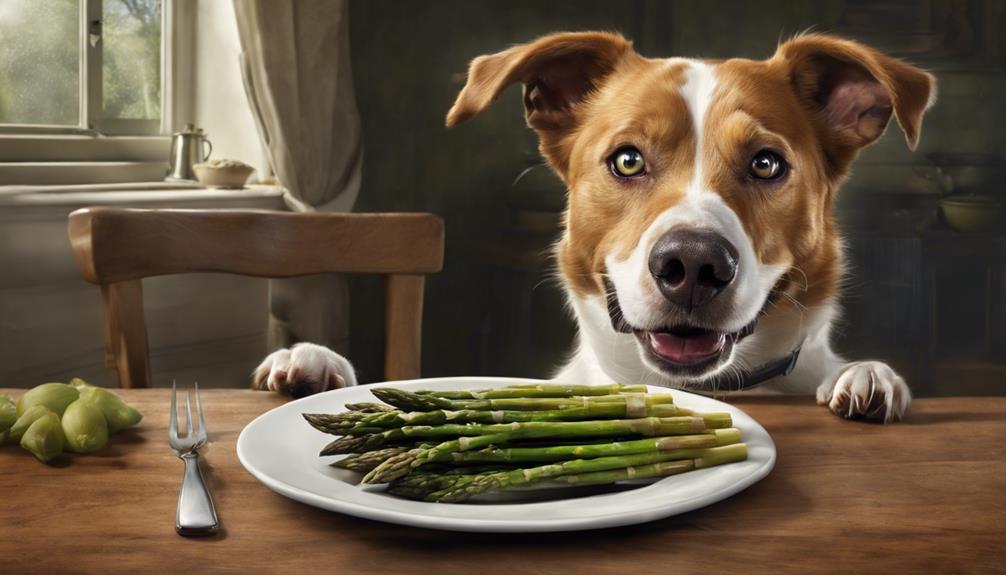Get ready for a structured **12-week puppy crate training schedule** that will help your new furry friend develop great habits and have a safe place to call their own. Begin by slowly introducing the crate in the first week, using treats and toys to create a positive association. Over the following weeks, gradually increase crate time, **establish meal routines**, bathroom breaks, playtime, and naps, introduce safe toys, and stick to a consistent schedule. Manage nap times, adjust feeding times, and transition to using the crate at night with patience and consistency. By following this step-by-step plan, you’ll be setting up your puppy for a happy and well-adjusted life. Don’t miss out on this opportunity to create a positive environment for your furry companion!
Key Takeaways
- Gradually increase crate time to build comfort and positive association.
- Provide structured feeding, potty breaks, playtime, and nap routine.
- Monitor behavior, adjust pace, and use positive reinforcement consistently.
- Implement soothing techniques for nighttime crate use.
- Ensure a calm environment with supervised play and balanced schedule.
Week 1: Introduction to Crate Training
During Week 1 of puppy crate training, ease your pup into the process by introducing them to the crate in a quiet area. The crate should be a welcoming space for your puppy, so use treats and toys to help create positive associations.
Begin by keeping the initial crate sessions short to prevent any stress or anxiety for your furry friend. Encourage your puppy to enter and exit the crate voluntarily, making it a positive experience.
It's important to start practicing feeding meals inside the crate to build comfort and familiarity. This will help your puppy see the crate as a safe and cozy den rather than a place of confinement.
Week 2: Gradual Crate Familiarization

When beginning Week 2 of crate training, it's crucial to gradually introduce the crate to your puppy.
You can do this by keeping the door open and allowing your puppy to explore the crate at their own pace.
Creating a positive association with the crate is vital to making it a secure and comforting space for your furry friend.
Slowly Introduce Crate
To facilitate the gradual introduction of the crate to your puppy, encourage exploration by leaving the crate door open and placing treats or toys inside.
- Allow Freedom: Let your puppy voluntarily move in and out of the crate during the day to become familiar with it.
- Short Intervals: Gradually close the crate door for brief periods while your puppy is inside, rewarding calm behavior with treats or praise.
- Slow Progression: Increase the time spent in the crate slowly, focusing on positive reinforcement to create a secure and comforting environment.
- Constant Supervision: Monitor your puppy's reactions to being crated closely, adjusting the training pace based on their comfort level and progress.
Positive Crate Association
Start by encouraging your puppy to explore the crate voluntarily with the door open and enticing treats inside to establish a positive association. Essential familiarization with the crate is vital for successful crate training.
Allow your puppy to approach the crate at their own pace, without any pressure. Toss treats near the crate and gradually inside to entice them further. Use verbal cues like 'crate' or 'go to bed' to help guide your puppy towards the crate.
Repeat this process daily to reinforce the positive association and help your puppy feel comfortable and secure in their crate. Creating a safe and inviting environment will make the crate a place your puppy willingly goes to for rest and relaxation.
Week 3: Increasing Crate Time
Gradually extending the time your puppy spends in the crate during week 3 is crucial for their comfort and adjustment. To guarantee a smooth shift and positive association with the crate, follow these steps:
- Increase Crate Time in Small Increments: Add a few minutes to each session to help your puppy acclimate gradually.
- Monitor Behavior and Comfort Level: Pay attention to how your puppy reacts to longer crate times. If they show signs of distress, go back to shorter intervals and progress more slowly.
- Utilize Positive Reinforcement: Reward good behavior with treats and praise when your puppy remains calm in the crate. This will help them associate the crate with positive experiences.
- Provide Ample Opportunities for Elimination and Play: Before longer crate sessions, make sure your puppy has had enough time for potty breaks and play to prevent accidents and excess energy in the crate.
Week 4: Implementing Toys in Crate
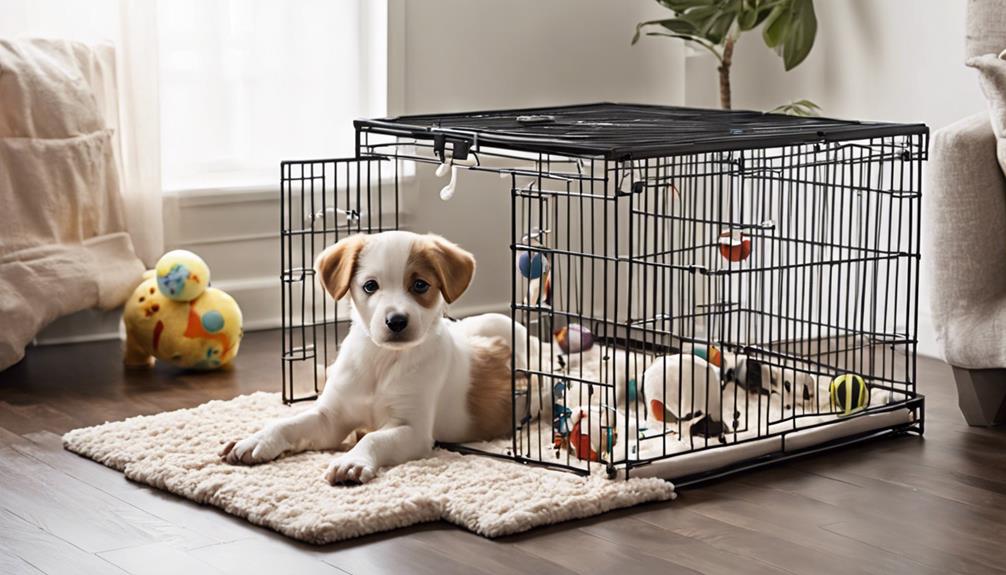
As your puppy becomes more comfortable with spending increased time in the crate during Week 3, it's time to introduce safe and engaging toys into their crate in Week 4. Choose toys that are important and durable, ensuring they're appropriate for your puppy's age and size to prevent any choking hazards.
It's important to rotate the toys regularly to keep your puppy entertained and prevent boredom from setting in. Incorporating interactive toys like puzzle feeders can help stimulate your puppy's mental and physical activity while they're in the crate.
Avoid toys with small parts or strings that could pose a choking risk to your puppy. Always prioritize their safety when selecting toys for crate time. Interactive toys not only keep your puppy engaged but also provide mental stimulation, which is essential for their overall well-being.
Week 5: Establishing Crate Routine
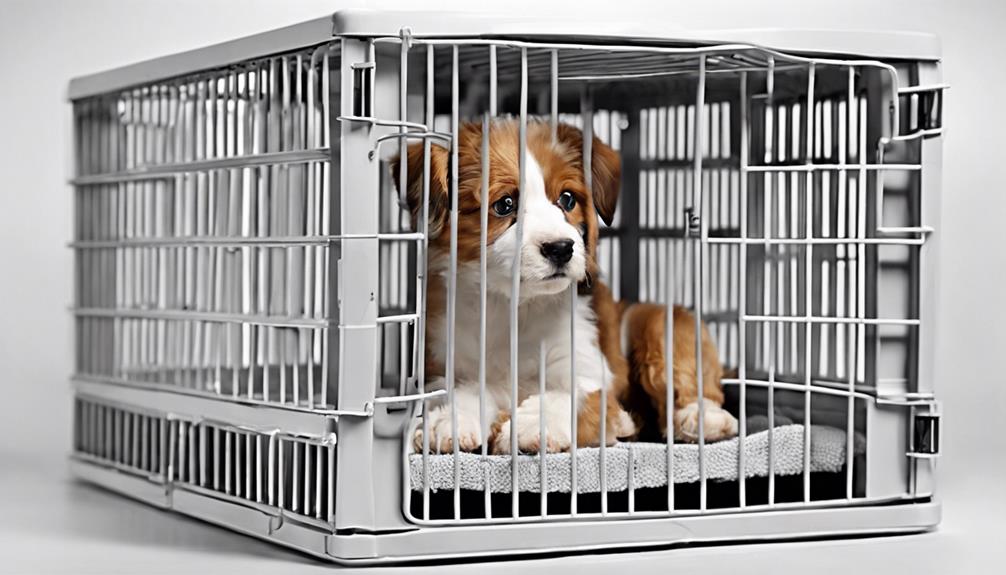
To establish a solid crate routine in Week 5, remember to maintain consistency in your crate schedule.
Guarantee your puppy has positive experiences in the crate by offering treats and comforting items.
Slowly extend the time spent in the crate each day to help your puppy adjust gradually.
Crate Schedule Consistency
During week 5 of puppy crate training, establish a consistent routine that includes specific times for feeding, potty breaks, playtime, and nap sessions in the crate. To guarantee effective crate schedule consistency, follow these steps:
- Feeding Schedule: Offer meals at the same times each day to regulate your puppy's feeding routine.
- Potty Breaks: Take your puppy outside after meals, playtime, and naps to reinforce proper potty habits.
- Playtime: Engage in interactive play sessions to burn off excess energy and promote mental stimulation.
- Nap Times: Schedule quiet time in the crate for your puppy to rest and recharge between activities.
Consistency in these aspects of crate training during week 5 will help your puppy adjust to the routine and set the stage for successful future training endeavors.
Positive Crate Experiences
Create a welcoming environment in the crate by incorporating engaging toys and activities to make it a positive space for your puppy. Introduce the crate as a place for fun and relaxation by including high-value treats and meals inside. Utilize interactive toys to keep your puppy entertained and make the crate a pleasant place to be.
Gradually increase the time your puppy spends in the crate throughout the day to help them adjust comfortably. Incorporate nap times in the crate to establish a routine for rest and relaxation. Maintain a consistent schedule for feeding, playtime, and crate use to reinforce positive experiences.
Consistency and positive reinforcement are key to successful crate training.
Slowly Extend Crate Time
Gradually extend the time your puppy spends in the crate during week 5 of training by increasing it by 5-10 minutes each day. Here's how to do it effectively:
- Use positive reinforcement techniques like treats and toys to create a positive association with the crate.
- Monitor your puppy's behavior closely during the gradual extension to make sure they're comfortable and not showing signs of distress.
- Stay consistent with the schedule and be patient as your puppy adjusts to spending more time in the crate.
- Prioritize your puppy's comfort and well-being throughout the extension process to make crate training a positive experience.
Week 6: Monitoring Puppy Behavior
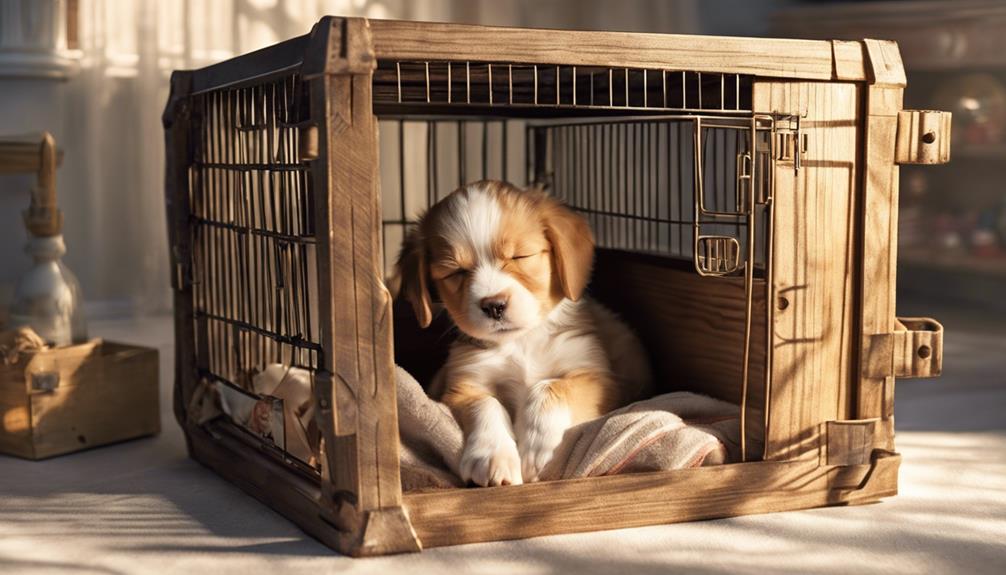
In Week 6 of the puppy crate training schedule, closely monitor your puppy's behavior for signs indicating the need for a potty break or attention. Observing behaviors like restlessness, pacing, vocalizations, or scratching at the crate can signal that your puppy needs to go outside or requires some form of interaction. It's essential to keep track of your puppy's water intake to predict when they might need a bathroom break and avoid accidents inside the crate.
Take note of any patterns in your puppy's behavior to establish a routine and make necessary adjustments to the schedule. Supervise playtime diligently to prevent accidents and reinforce positive behaviors. By closely monitoring your puppy's behavior during Week 6, you can better understand their cues and needs, setting the stage for successful crate training in the following weeks. Remember, consistency and attentiveness are key to helping your puppy learn and thrive in their crate training journey.
Week 7: Managing Rest Periods
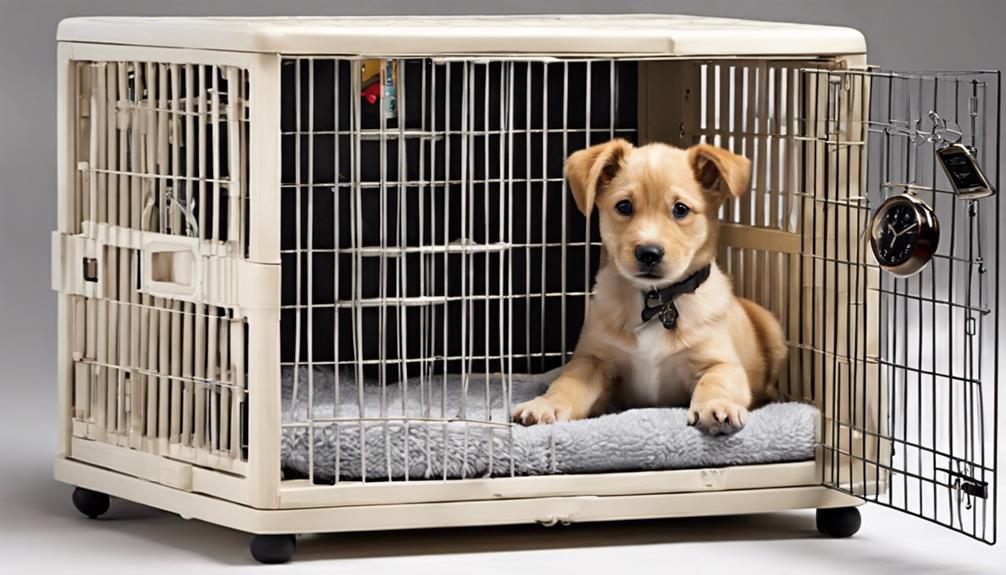
During Week 7 of puppy crate training, it's important to manage rest periods effectively.
Make sure to provide your puppy with adequate rest in the crate to prevent overstimulation.
Setting up a calm environment and following duration guidelines will help your puppy relax and recharge.
Rest Period Importance
Ensuring your puppy's well-being includes incorporating essential rest periods into their crate training routine to prevent overstimulation and exhaustion. Here are some key points to contemplate concerning the importance of rest periods during crate training:
- Preventing Overstimulation: Rest periods in the crate help your puppy relax and recharge, avoiding becoming overly excited or overwhelmed.
- Ensuring Supervision: While your puppy is outside the crate, close supervision is crucial to prevent accidents and promote safety.
- Encouraging Potty Training: Taking your puppy outside immediately after crate time increases the chances of successful potty training.
- Monitoring Water Intake: Regulating your puppy's water consumption, especially before bedtime, reduces the likelihood of nighttime accidents.
Duration Guidelines
Start incorporating brief rest periods into your puppy's crate training routine during week 7 to prevent exhaustion and promote a healthy training schedule. Puppies at this stage need supervision outside the crate to make sure they behave appropriately. Immediate outdoor breaks after crate time are crucial for reinforcing potty training.
Monitoring your puppy's water intake can help establish a consistent schedule. Limiting water before bedtime reduces the need for nighttime bathroom breaks. By closely watching your puppy's habits, you can tailor the schedule to their needs.
Calm Environment Setup
To promote a peaceful and restful environment for your puppy during Week 7, make sure the crate is positioned in a quiet area away from high-traffic locations. Here are some tips for setting up a calm environment for your puppy:
- Crate Placement: Position the crate in a tranquil area to minimize distractions and create a peaceful environment for your puppy to relax.
- Good Ventilation: Guarantee the crate area has good ventilation to provide proper airflow and comfort for your puppy during rest periods.
- Consistent Feeding Routine: Stick to a regular feeding schedule to regulate energy levels and encourage relaxation when it's time for your puppy to rest.
- Supervised Playtime and Balanced Schedule: Monitor playtime to prevent overstimulation and establish a balanced routine that includes ample rest periods for your puppy's overall well-being.
Week 8: Consistent Crate Schedule
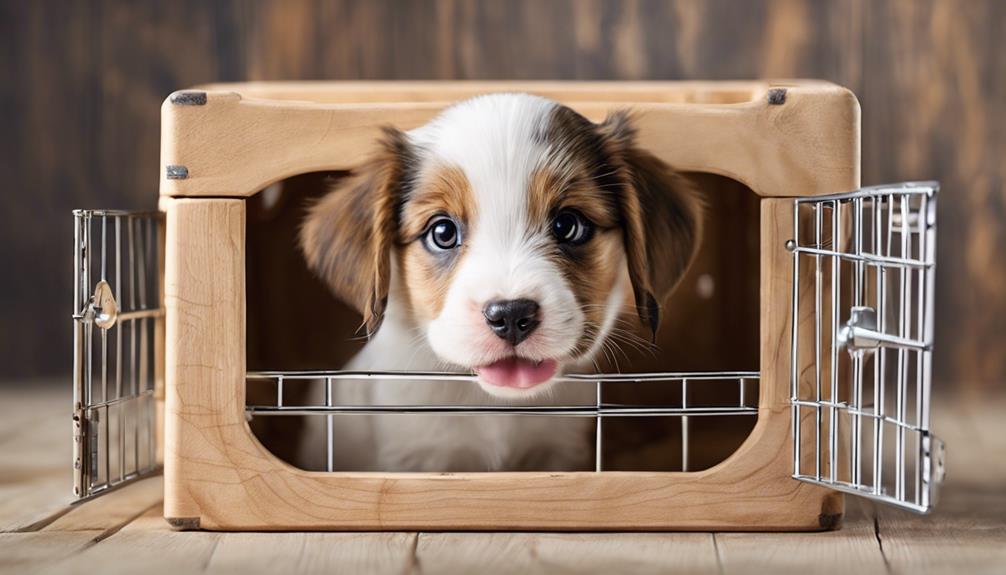
Maintain a steady schedule for your puppy's crate training during Week 8 to reinforce positive habits effectively. Structured meal times and potty breaks help establish a routine for your puppy, aiding in their understanding of when to expect meals and when to go outside. Utilize positive reinforcement techniques such as treats or praise when your puppy exhibits desired behaviors inside the crate. This encourages them to view the crate as a safe space and reinforces the idea that good behavior leads to rewards. Additionally, incorporating short play or training sessions within the crate can help keep your puppy engaged and prevent boredom.
| Steady Schedule | Reinforcement Techniques |
|---|---|
| Set specific times for meals and potty breaks | Use positive rewards for desired behaviors |
| Ensure regular play and training sessions | Create a safe and comfortable space in the crate |
Week 9: Adapting Feeding Schedule
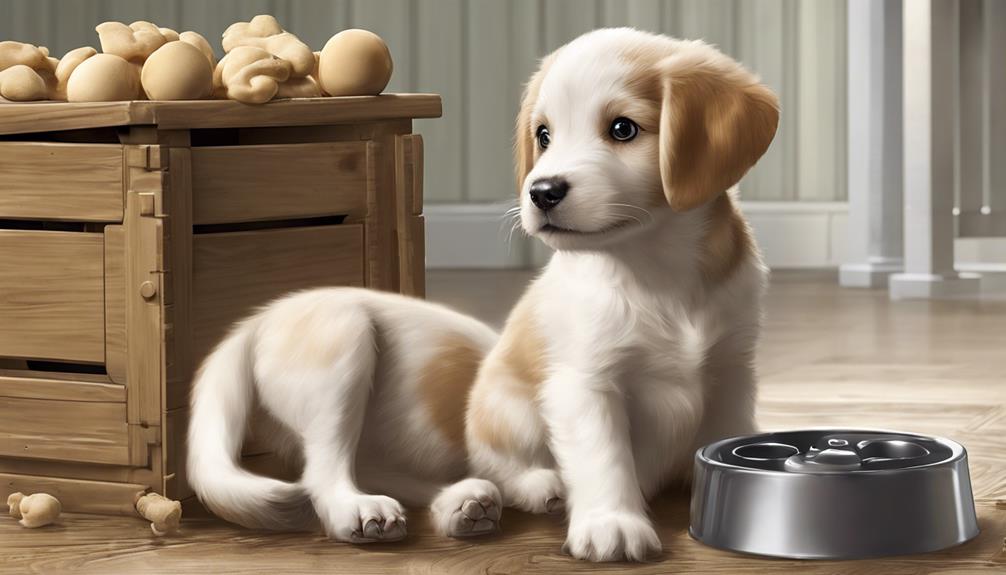
Adjust your 9-week-old puppy's feeding schedule to meet their growing needs by offering smaller, frequent meals throughout the day. To guarantee your puppy's health and well-being, follow these guidelines:
- Divide your puppy's daily food portion into several smaller meals to prevent overeating and aid digestion.
- Provide fresh water at all times to keep your puppy hydrated, especially during meal times.
- Monitor your puppy's weight regularly and adjust the feeding amounts accordingly to support their growth.
- Seek advice from a veterinarian for expert guidance on the specific nutritional requirements for a 9-week-old puppy.
Week 10: Transitioning to Nighttime Crate Use

As your puppy reaches week 10, consider shifting them to sleeping in their crate at night. This change is an important part of crate training, teaching your puppy to feel secure and comfortable in their crate even during the nighttime.
Start by gradually increasing the duration of nighttime crating, allowing your puppy to adjust to this new routine. Make sure the crate is cozy and inviting, with soft bedding and familiar scents to make it a comforting space for your puppy's rest.
Implement soothing techniques such as playing soft music or placing a familiar blanket in the crate to help ease any anxiety your puppy may feel initially.
Monitor your puppy's behavior during this adjustment period and be prepared to adjust the nighttime crating schedule as needed. Patience and consistency are key in the process, offering positive reinforcement and support to help your puppy feel at ease in their crate at night.
With time and practice, your puppy will learn to associate their crate with safety and security, making bedtime a peaceful and restful experience for both of you.
Frequently Asked Questions
Should I Crate Train My 7 Week Old Puppy?
You should definitely crate train your 7-week-old puppy. It helps with potty training, establishes routine, and creates a safe space for them. Consistent training will set a good behavior foundation. Remember, young puppies may need more frequent potty breaks.
Can I Leave My 8 Week Old Puppy in a Crate for 2 Hours?
You can leave your 8-week-old puppy in a crate for up to 2 hours. Remember, puppies at this age have limited bladder control. Keep an eye on their behavior and gradually increase crate time as they grow and develop.
How Do You Crate Train a Dog in 7 Days?
To crate train a dog in 7 days, gradually increase crate time daily, make the crate inviting with treats and toys, stick to a consistent schedule for feeding and breaks, use calming cues, and adapt the plan as needed for success.
Should I Put My 8 Week Old Puppy in a Crate at Night?
Yes, you should put your 8-week-old puppy in a crate at night. Start with short intervals and gradually increase the time to help them adjust. Limit water intake before bedtime and provide comforting items for a smooth adjustment.
Can I Use the 12-Week Puppy Crate Training Schedule for Nighttime Success?
Yes, you can use the 12-Week Puppy Crate Training Schedule for nighttime success. Consistent implementation of the puppy crate training schedule will help your puppy become accustomed to their crate and ease the transition to sleeping through the night. Gradually increase the crate time to ensure they’re comfortable.
Conclusion
As you continue to follow this 12-week puppy crate training schedule, remember that consistency is key.
Just like building a house brick by brick, training your puppy takes time and patience.
By sticking to the routine and gradually increasing crate time, your puppy will learn to see the crate as a safe and comfortable space.
Keep up the good work, and soon enough, your furry friend will be crate trained and thriving!
